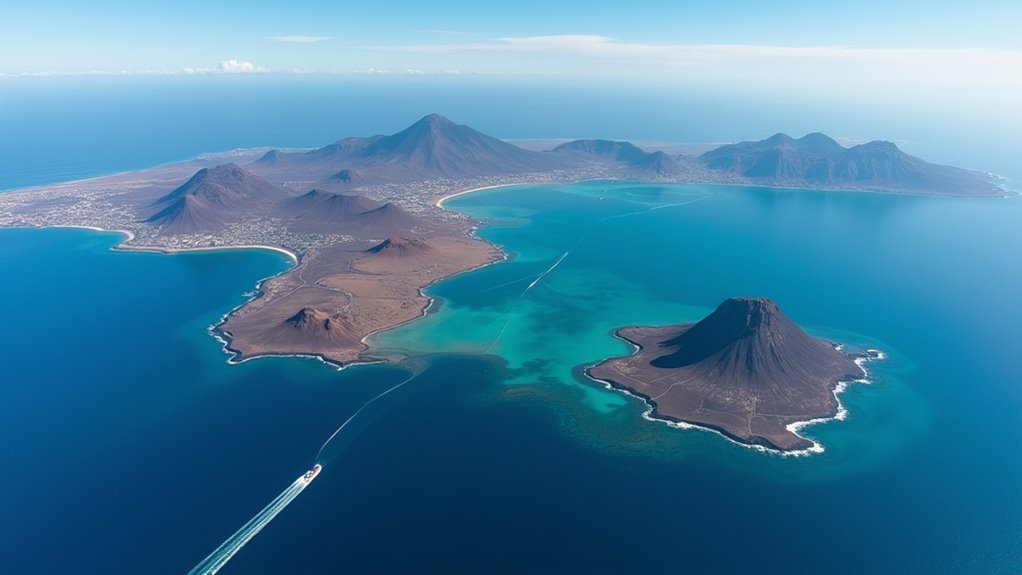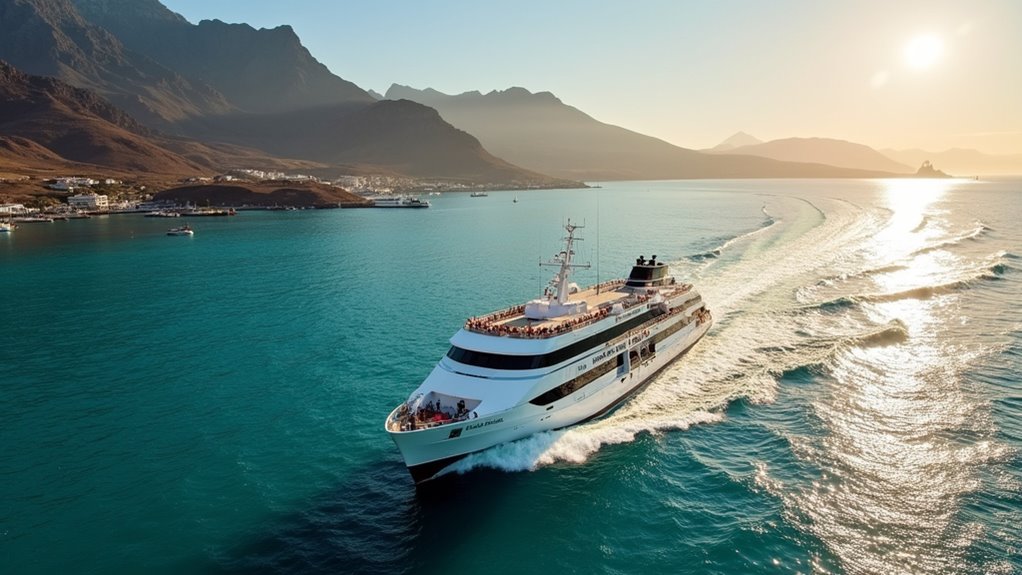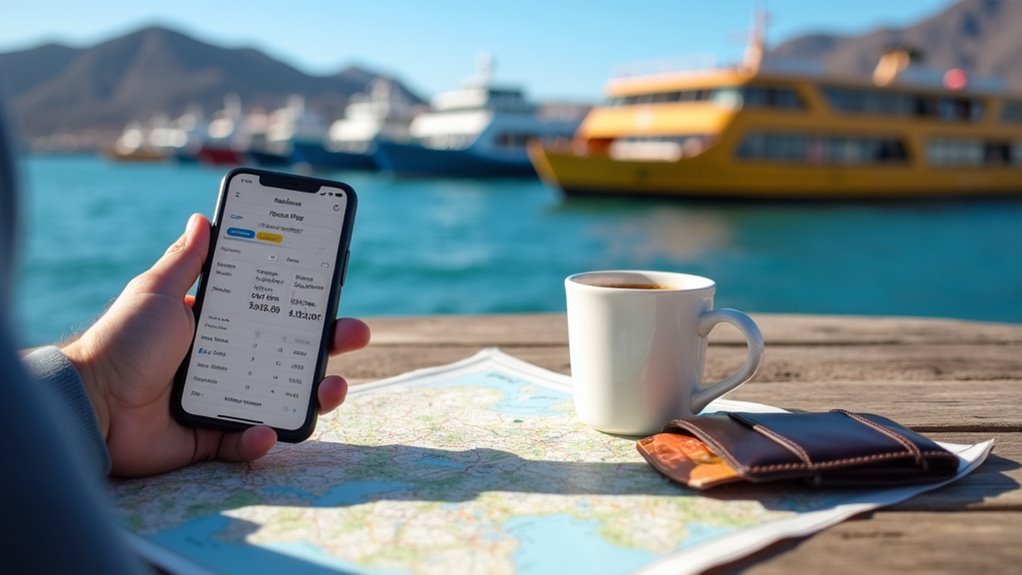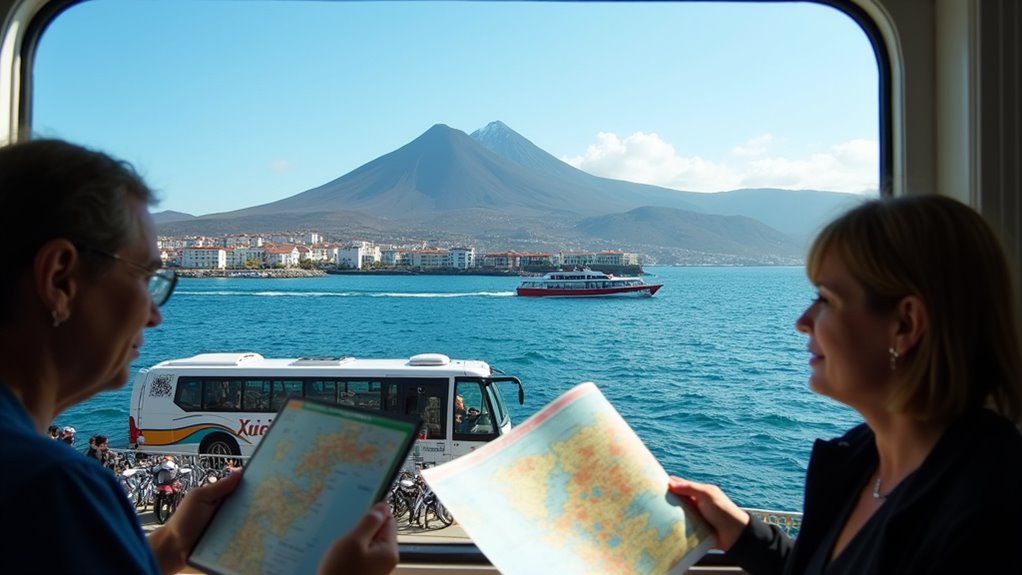Physical Address
304 North Cardinal St.
Dorchester Center, MA 02124
Physical Address
304 North Cardinal St.
Dorchester Center, MA 02124

Plan your perfect Canary Island-hopping adventure with ferries or flights, but which method offers the best experience?
You can hop between the Canary Islands via ferry (cheaper, scenic, €15-100) or flight (faster, €40-90). Ferries connect most islands daily through companies like Naviera Armas and Fred Olsen, while airlines Binter Canarias and CanaryFly offer quick inter-island flights. Travel during May-June or September-October for fewer crowds and better prices. Book early using Ferryhopper for ferries or airline websites for flights. Stick around to discover the perfect island-hopping itinerary for your adventure.

When you’re planning to hop between the Canary Islands, getting familiar with the archipelago’s layout will save you time and money. This Spanish territory falls into two neat clusters off Africa’s northwest coast.
The eastern bunch includes Lanzarote and Fuerteventura, plus tiny La Graciosa. Head west and you’ll find Gran Canaria, Tenerife, La Gomera, El Hierro, and La Palma. Tenerife’s your biggest island, home to Mount Teide—Spain’s tallest peak. The impressive Teide volcano (3,715m) is also the third tallest volcano on Earth on a volcanic ocean island.
For practical planning, remember the islands span two provinces: Las Palmas and Santa Cruz de Tenerife. Each island packs its own personality—volcanic landscapes, beaches, forests, you name it. Exploring these stunning destinations requires careful consideration of transportation options between islands.
Grab a detailed map from tourist offices or download one to your phone. Google Maps works great for plotting day trips once you’ve landed.
Although the Canaries boast year-round sunshine, timing your island-hopping adventure strategically can save you cash and headaches. The sweet spots for budget-savvy travelers are May-June and September-October, when you’ll enjoy pleasant weather without battling tourist crowds.
Time your Canary Island adventure wisely – shoulder seasons offer sunshine without the crowds or premium prices.
Ferry service runs year-round, so you’re never stranded, but your wallet will thank you for traveling in shoulder seasons. February travelers can enjoy the vibrant Carnival of Santa Cruz, a popular cultural event that showcases the islands’ unique heritage. Similar to European capitals, the Canary Islands each have their own distinct cultural identity worth exploring.

Moving between the Canary Islands means getting familiar with the ferry network that keeps these Atlantic gems connected. You’ll find five main operators: Naviera Armas, Fred Olsen Express, Lineas Maritimas Romero, Naviera Nortour, and Biosfera Express.
Popular routes like Lanzarote to Fuerteventura run 25 times daily with 35-minute crossings, while Fred Olsen’s high-speed catamarans zip between Tenerife and Gran Canaria in just 80 minutes.
Budget about €15 for short hops like Lanzarote to La Graciosa, €40-60 for medium routes, and €50-100+ for longer journeys. Tenerife serves as the primary hub for many ferry connections, with routes linking it to islands like Gran Canaria, Fuerteventura, and Lanzarote. Much like the historic Split in Croatia, these ferry routes offer breathtaking coastal views during your journey.
Corralejo Port bustles with 223 weekly sailings, making it the network’s busiest hub. During summer, frequencies increase, so book early to snag seats among the 1,193 weekly sailings system-wide.
For travelers seeking the quickest way around the Canaries, island-hopping by air is your best bet. Binter Canarias and CanaryFly zip between all major islands in under an hour, with ATR 72 twin-turboprops handling most routes.
When flying between islands, keep these handy tips in mind:
La Graciosa’s the only odd duck – you’ll need air travel plus a boat ride to reach it. With flight times as short as 30 minutes between major islands like Tenerife and Gran Canaria, you’ll save significant time compared to ferry travel. Unlike Dalmatian islands in Croatia, the Canaries require more planning due to greater distances between islands.

When planning your Canary Islands expedition, transportation costs can make or break your budget. Ferries typically offer cheaper options than flights, with the Lobos to Corralejo route being a steal at just $32.
Meanwhile, flights will set you back €40-90 for a one-way ticket.
You’ll save a pretty penny by booking ferry tickets early and snagging round-trip discounts.
If you’re island-hopping for weeks, public transit might be your best bet versus renting a car with gasoline running around $5.84 per gallon.
Don’t forget that prices swing with the seasons—traveling off-peak means more cash for sangria!
The average daily transportation cost per person is approximately $63, which adds up quickly when visiting multiple islands.
Consider vehicle-sharing with fellow travelers or look into package deals that bundle your transport and lodging for extra savings.
Like its Spanish mainland counterpart Malaga, the Canary Islands offer beach town vibes but with their own unique volcanic landscapes.
With your budget intact, let’s explore what you can actually see in a single day. Island-hopping doesn’t always require overnight stays – plenty of day-trip options exist for the savvy traveler.
Various excursion options allow you to explore neighboring islands while departing and returning on the same day without the hassle of overnight arrangements.
For travelers wanting a taste of the Mediterranean, the Canary Islands offer experiences similar to Balearic Islands with their own distinct volcanic landscapes.
Remember to factor in port/airport transfer times and check weather forecasts – rough seas can derail even the best-laid plans.

Planning a week in the Canaries lets you truly soak up the islands’ diverse personalities instead of just skimming the surface. With seven days to play with, you’ve got options galore.
Nature lovers should check out the La Palma-El Hierro-La Gomera circuit. Start with Caldera de Taburiente’s trails, catch some stars at Roque de los Muchachos, then ferry to El Hierro for coastal swims. Cap it off with La Gomera’s ancient laurel forests. Alternatively, explore the Western Canary Islands with a 7-day itinerary covering four scenic islands including Tenerife and La Palma.
Beach bums and volcano buffs might prefer the Eastern Islands route through Fuerteventura and Lanzarote. Ride camels on Corralejo Dunes, hop over to tiny Lobos Island, then ferry to Lanzarote for Timanfaya’s otherworldly landscapes and local vineyards. For those extending their Spanish adventure, the mainland city of Malaga’s beaches offers a perfect complement to the volcanic shores of the Canaries.
For a mixed bag, try Tenerife-La Gomera-Lanzarote, hitting rainforests, national parks, and lava tubes.
Although exploring the Canary Islands with mobility limitations might seem formidable, you’ll find a surprising number of accessible transportation options across the archipelago. Most islands have adapted their services to accommodate various mobility needs without breaking the bank.
Mobility challenges? The Canary Islands offer accessible options that won’t drain your travel budget.
Here’s what’s available to help you get around:
Don’t let limited mobility stop your island-hopping adventure—the Canaries have made real strides in accessibility. Many travelers find the accessibility options here rival those at popular European destinations like Lake Balaton in Hungary. Private car hire companies throughout the archipelago offer adapted vehicles for travelers who prefer independent travel between attractions.

Now that we’ve covered accessible options, let’s look at how you’ll get around on each specific island. The locals call buses “guaguas,” and they connect most major spots across all islands.
On Tenerife, you’ll find the most robust system with Titsa’s 140+ bus routes and convenient trams in the cities.
Gran Canaria offers solid coverage through the Global bus company.
Lanzarote’s network is smaller but hits major tourist areas.
The smaller islands (La Gomera, El Hierro, La Palma, and Fuerteventura) have more limited schedules, especially on weekends.
You’ll save money with travel cards on frequent routes.
If buses aren’t cutting it, consider renting a car or motorbike – often worth the splurge for reaching those hidden beaches and mountain villages the buses don’t serve. While the Canary Islands are generally affordable for transportation, popular tourist areas like Ibiza tend to have higher travel costs during peak season. On most islands, you can use Pidetaxi app to order taxis when public transportation isn’t available.
When it comes to booking your island-hopping adventures, securing the right transportation can make or break your Canarian vacation. Locals know the ropes, and you should too! Book flights early—especially with Binter Canarias, CanaryFly, or Air Europa—since residents snap up seats quick as lightning. You’ll appreciate the streamlined experience as security procedures are minimal for inter-island flights.
For penny-pinchers, ferries are your best bet. Fred. Olsen and Naviera Armas won’t empty your wallet like flights might. Tenerife offers relatively budget-friendly options compared to other European destinations, making island-hopping more accessible.
Now that you’re armed with all the island-hopping know-how, you’ll navigate the Canaries like a local! Remember, about 85% of inter-island travelers choose ferries over flights for the scenic views and wallet-friendly prices. Whether you’re catching the morning boat to Tenerife or hopping on a quick flight to Lanzarote, the journey between these beautiful islands is half the fun. Safe travels and happy exploring!